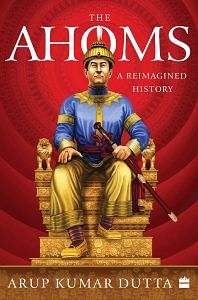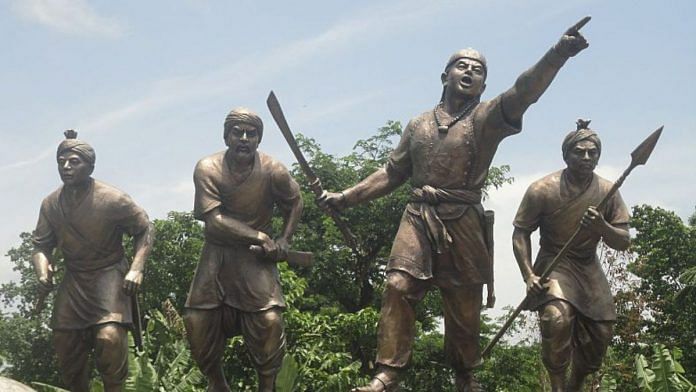Ram Singh had come to know from the men who arrived with the reinforcements that his son had been maltreated by Aurangzeb. This made his aversion to fight on behalf of the Mughal emperor even deeper. Yet there was no help for it—as a Rajput, he was oath-bound to the pledge made to Aurangzeb and had to attempt to bring this campaign to an end and oust the Ahoms from Guwahati. Thus commenced the final battle of Saraighat in March 1671—one in which the Ahoms under the leadership of Lachit Barphukan and Atan Buragohain dealt a mortal blow to Mughal expansionist ambitions.
As predicted by Ram Singh, it was a naval battle. This put the Mughals at a disadvantage, for their war-vessels had to move upstream against the mighty Brahmaputra currents while the Assamese boats could move in swiftly upon them. But then, Ram Singh had been heartened by the news that Lachit was gravely ill, and could not lead the Ahoms against his forces.
Ram Singh’s huge flotilla of boats swept in on the Assamese with all guns blazing, attacking the first of the opponent’s war boats at Saraighat, a little downstream of Guwahati. Simultaneously, some of the boats carried Mughal cavalry to a sandbank named Andharubali, the rampart at which spot had broken, as informed by spies, thereby having an opening for a land attack on the Itakhuli fort. But the Ahoms guessed his tactics and defended the waters near the sandbank fiercely even as the rampart was quickly repaired, and the cavalry had to turn back. It was a river battle the likes of which the hoary Luit had never seen.
Also read:
The whole of the Brahmaputra at the triangle between Kamakhya, Itakhuli and Aswakranta grew cluttered with boats; the flashes and thunderclaps of cannons being fired filled the air; drowning out the cries for help of men struggling in the waters. The red waters of the Brahmaputra turned even redder with human blood. Though, on the north bank, the men under Atan Buragohain were gaining the upper hand, those towards the south bank had been demoralized at not finding Lachit at the head. Soon the results of this demoralization began to unfurl against the Ahoms; one after another their boats gave way before the Mughal onslaught and then turned and fled.
With the reek of impending defeat befouling the air, boatmen at Itakhuli began transferring the barphukan’s personal effects to their crafts for the inevitable departure for Kaliabor. News of the looming defeat reached the ears of the gravely ill barphukan. He barked out instructions, and his attendants carried the entire bed onto a war-boat which rowed swiftly towards the enemy. A miracle occurred. At the sight of Lachit coming to lead them, the soldiers were energized with new courage and hope. The Assamese boats once again turned to confront the enemy. Patriotic cries rent the air as the fight to defend king and country was resumed; the Mughals could not resist the renewed Assamese onslaught and began to escape from the watery arena after heavy casualties. It was a decisive victory.
Lachit himself chased the Mughals up to Pandu from where his boat returned, but his forces continued the pursuit till Ram Singh’s forces had been sent packing beyond the river Manas. The full extent of Ahom territory was once more in their king’s possession. Even in defeat the chivalrous Ram Singh praised his adversary. ‘Every Assamese soldier is an expert in rowing boats, in shooting arrows, in digging trenches and in wielding guns and cannons,’ he remarked. ‘I have not seen such specimens of versatility in any other part of India.’ Lachit Barphukan did not recover from his illness and died a few months later, at the age of fifty-nine. Lachit’s elder brother Laluksola was appointed as the new barphukan.
Once again, the river Manas became the western boundary of the Ahom realm. At a place called Hadira on the bank of the river, an Ahom army outpost as well as a trading centre was set up and it began to be called the Hadirachowki by the local people. Since it marked the outer bounds of the Ahom empire, people from outside began calling it the Assamchowki, and it soon developed into an important trading centre. During the rainy season, the garrison stationed there would shift to a fort built upon a hill nearby. A functionary was appointed to administer the area and also keep an eye on trading activities. Having been comprehensively defeated, Ram Singh and his force retired to the traditional Mughal outpost at Rangamati and camped there, waiting for an opportunity to renew the campaign.
From then on Rangamati became the acknowledged Mughal administrative headquarters for the region. The Battle of Saraighat marked the pinnacle of military achievement of the Ahom kings and dealt a death blow to imperialistic Mughal aspirations of conquering the Valley of the Luit and perhaps marching into China. This was not the ultimate battle between the two adversaries—as we shall learn, there was to be another fight, but that was one of subterfuge rather than of martial valour. The hearts of the Mughals were really not in it and they were repulsed easily by the Assamese. ‘The crushing defeat at Saraighat crushed Mughal spirits. It proved that Lachit Barphukan and Atan Buragohain were master strategists who could be compared with great generals in any part of India.
They employed every strategy in the book to stem the advance of a far more powerful Mughal army— erecting strong fortifications at carefully chosen spots, especially beside the Brahmaputra which had always acted as a highway for invaders; getting Ahom forces to show themselves to the enemy and then pretending to flee and enticing them towards wellfortified traps to be ambushed; using the evil reputation of their land outside to instill terror into the hearts of Mughal soldiers by kindling their superstitious streak regarding magic and sorcery; not confronting the enemy on open ground but adopting hit-and-run tactics; taking advantage of the dark to launch night attacks; concealing war boats and troops at strategic places which could launch guerilla attacks on the enemy from the flanks and the rear; undertaking marvels of engineering construction, such as wooden stockades on the mighty Brahmaputra that could withstand powerful currents—few battles fought on the soil of Hindustan could match the complex but successful strategy employed at Saraighat.
It is a pity indeed that magnificent leaders of men like Lachit and Atan are not known outside our state and the great battle of Saraighat is ignored by Indian historians. ‘Unfortunately, as I had said before, the height of glory is almost invariably followed by a descent into nightmare … this was the case immediately following the defeat of the Mughal forces at Saraighat and the death of Lachit Barphukan. After the passing away of Chakradhwaj Singha in 1670, there was a power struggle of the most reprehensible kind and, within the space of eleven years, no less than seven kings were enthroned and then murdered!
 This excerpt from ‘The Ahoms: A Reimagined History’ by Arup Kumar Dutta has been published with permission from Harper Collins India.
This excerpt from ‘The Ahoms: A Reimagined History’ by Arup Kumar Dutta has been published with permission from Harper Collins India.



